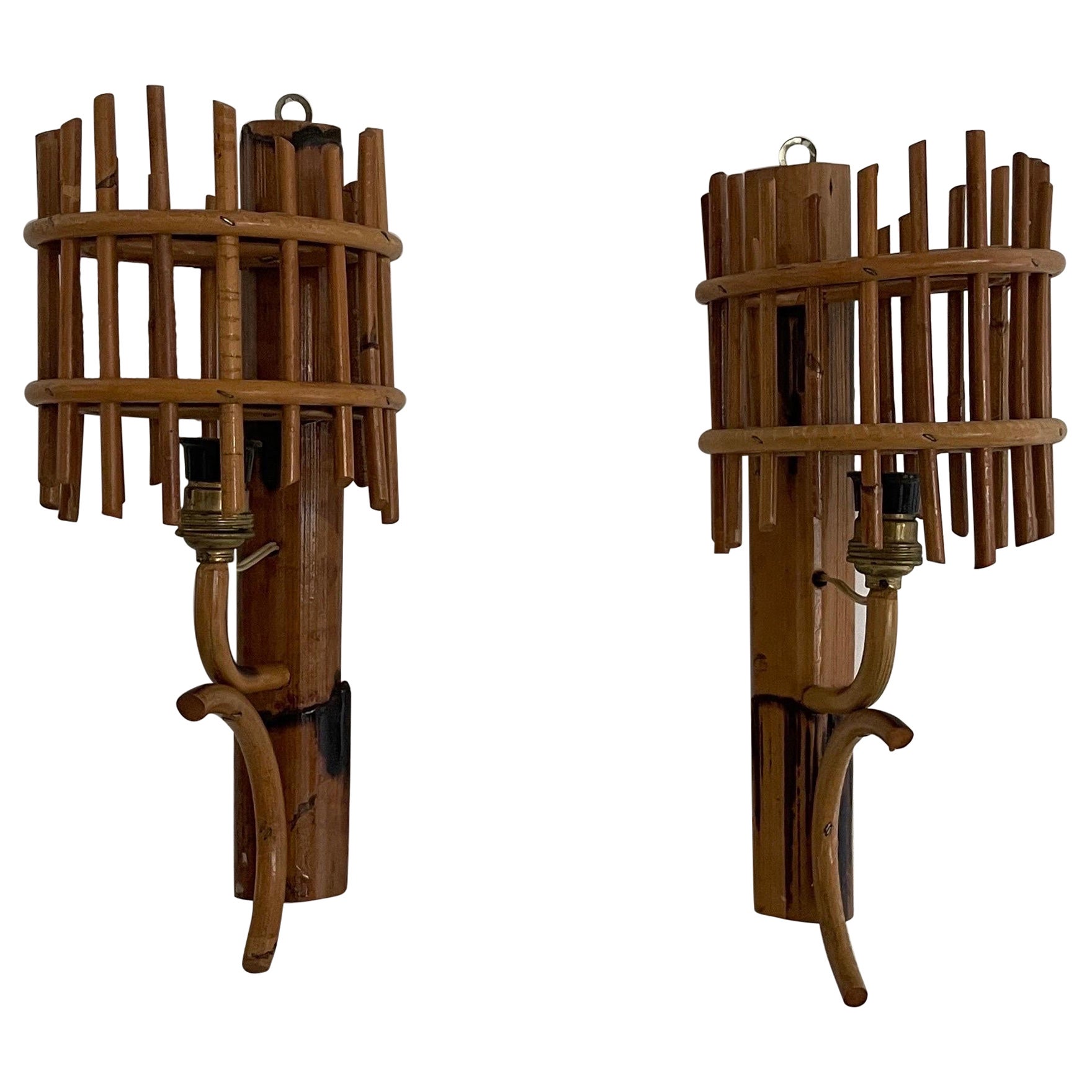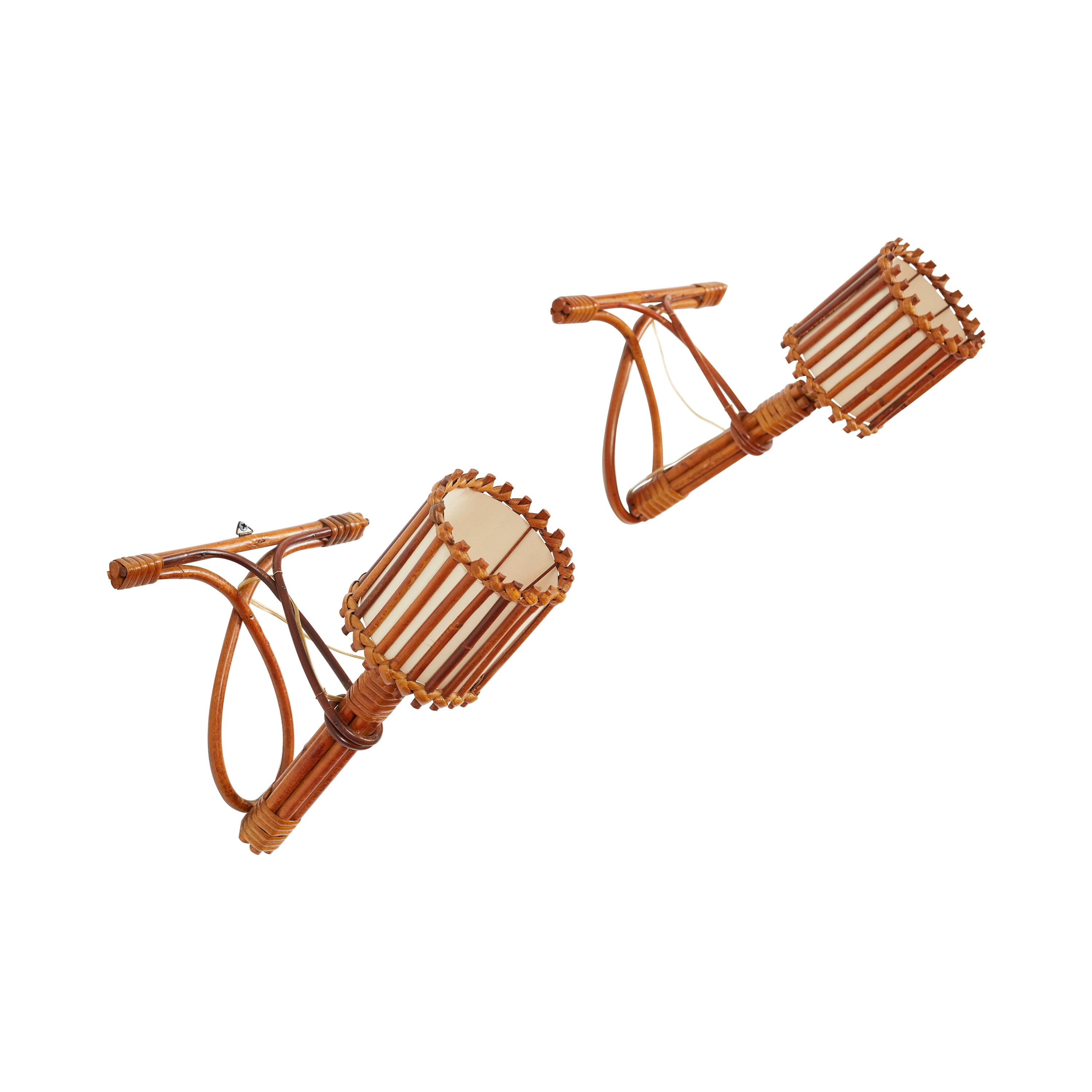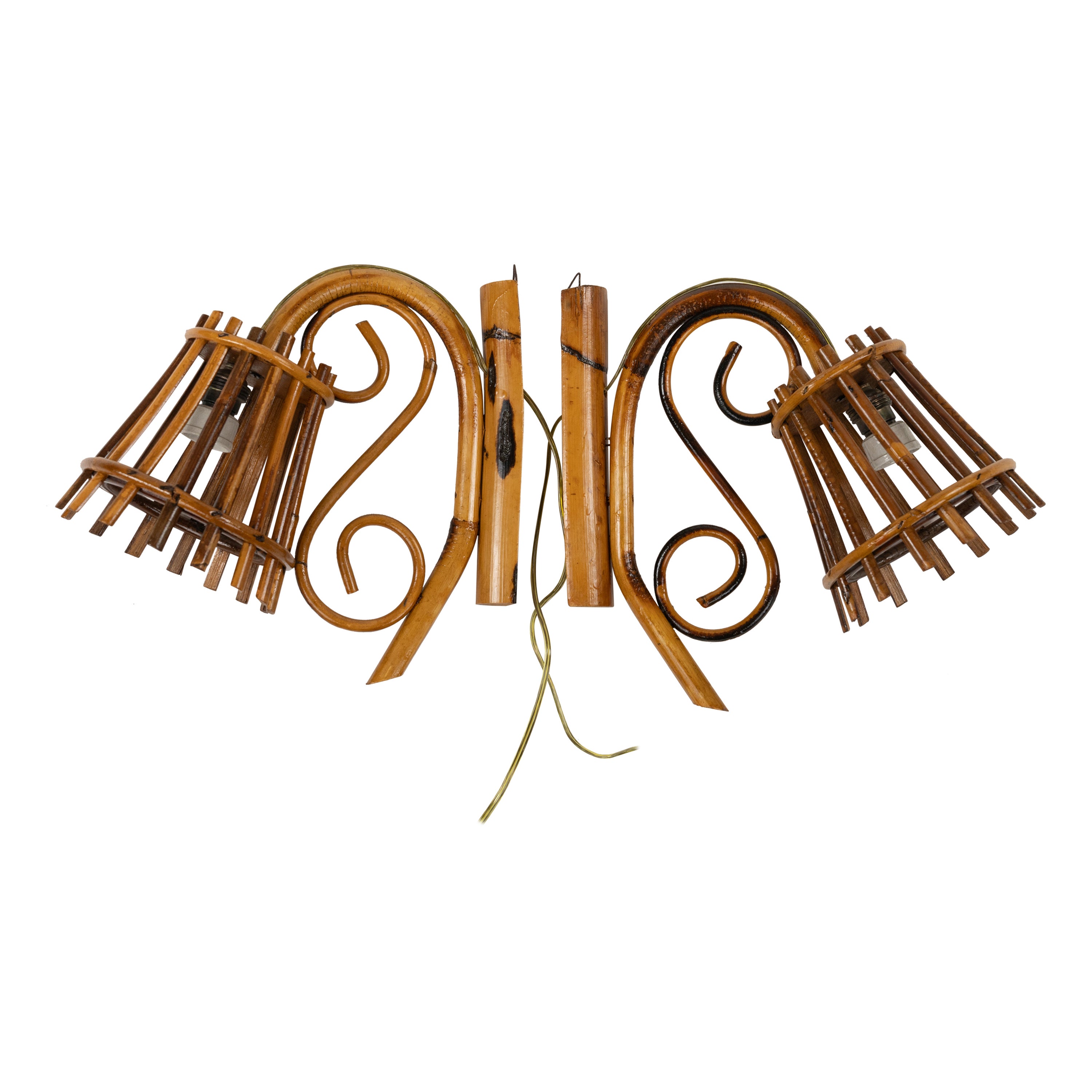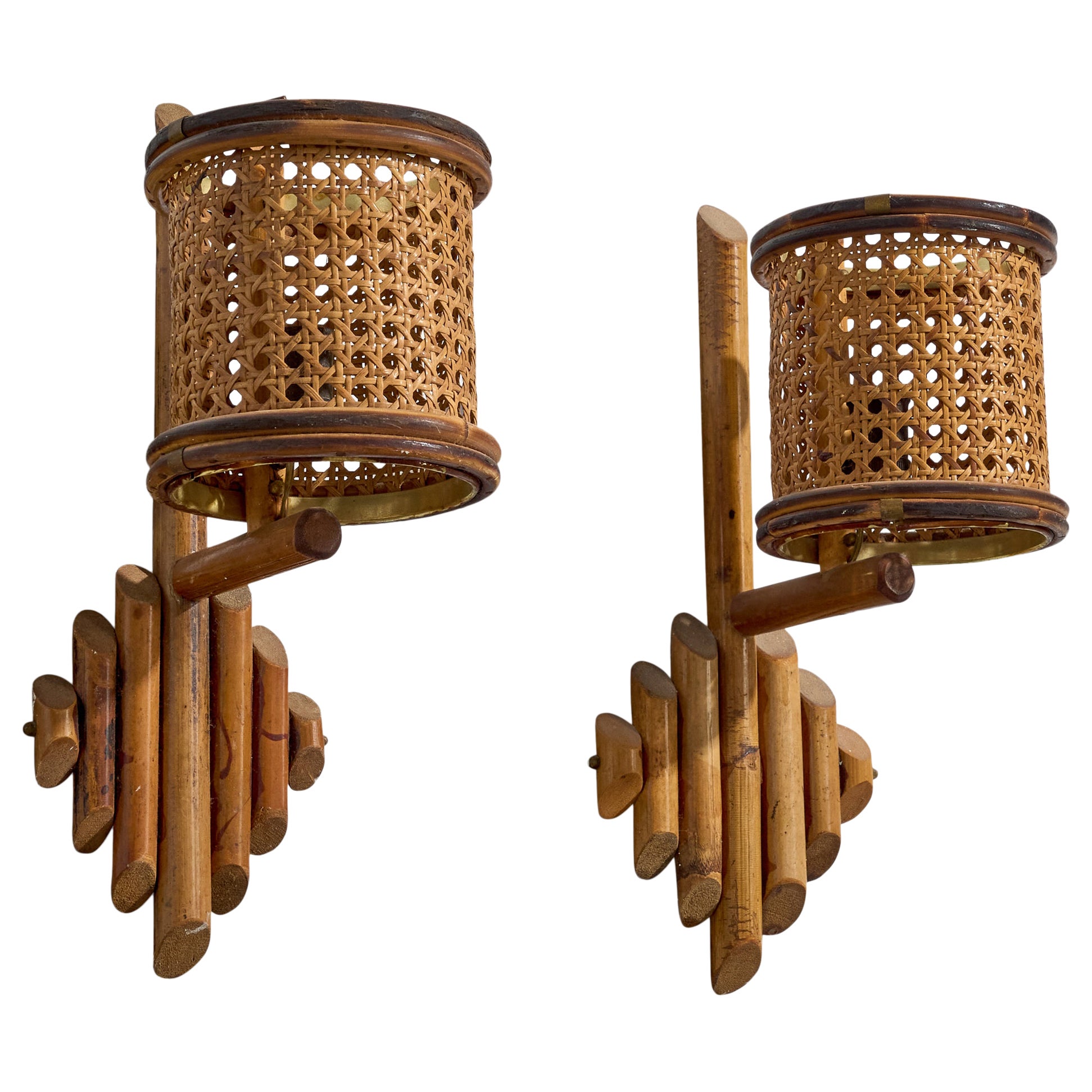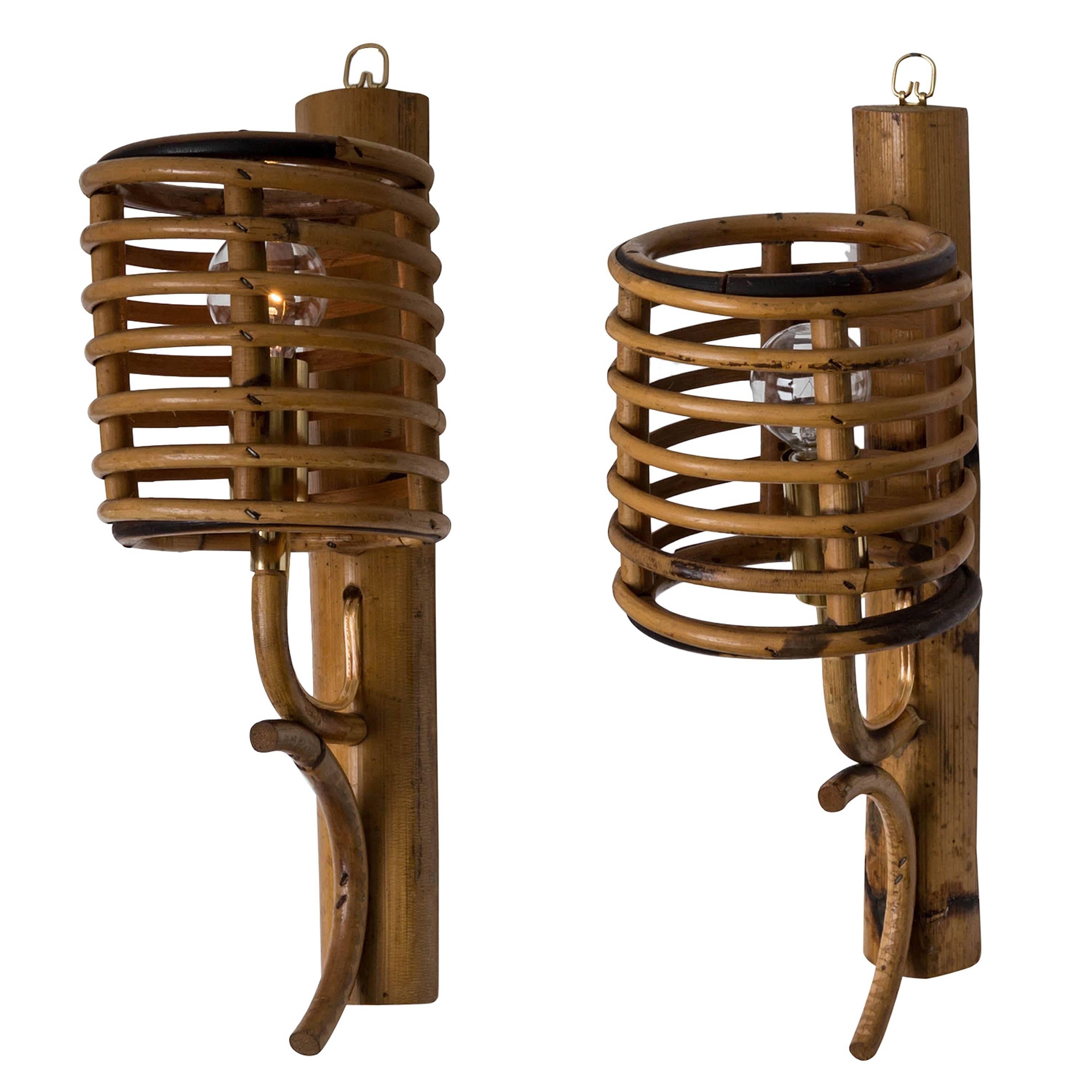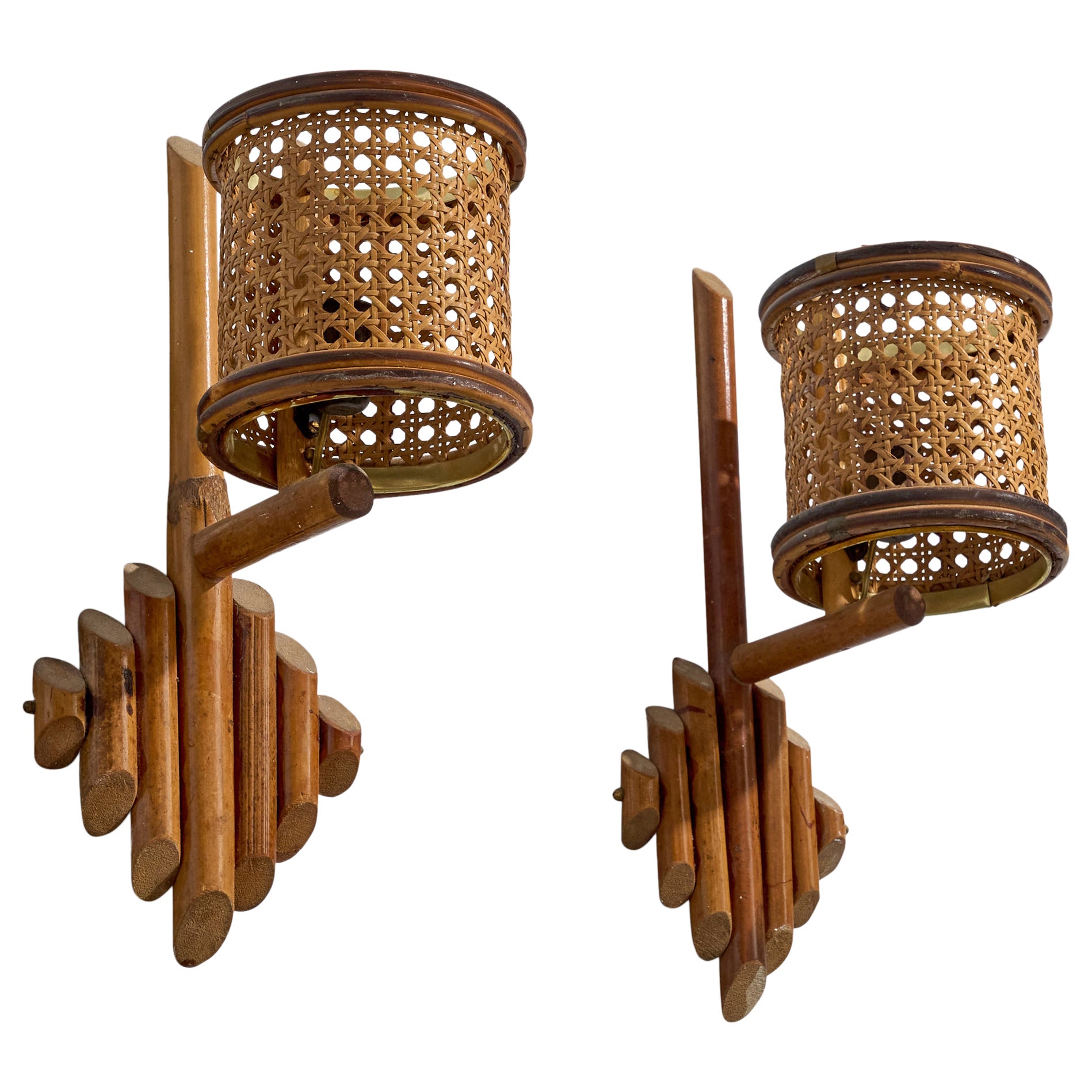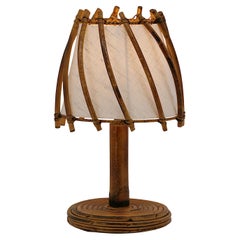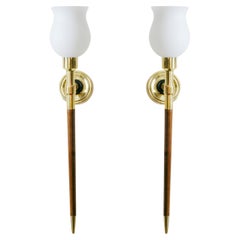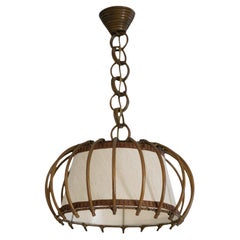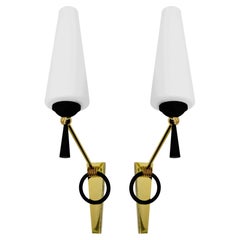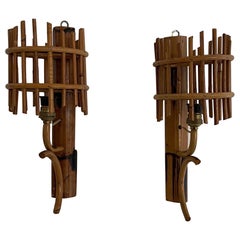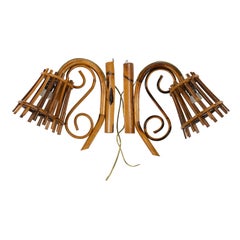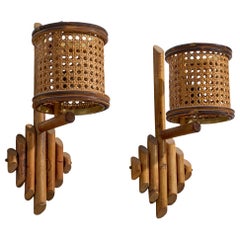Items Similar to Louis SOGNOT Double Bamboo Wall Sconce, 1950s
Want more images or videos?
Request additional images or videos from the seller
1 of 10
Louis SOGNOT Double Bamboo Wall Sconce, 1950s
$1,900
£1,429.57
€1,651.19
CA$2,685.20
A$2,913.85
CHF 1,544.08
MX$35,736.91
NOK 19,107.90
SEK 18,055.96
DKK 12,326.94
About the Item
Double bamboo wall sconce by Louis SOGNOT, France, 1950s. Bamboo and paper. Paper shades. Height: 12.6"(32cm), Width : 13"(33cm), Depth : 8.3"(21cm). Very good condition. Delivered wired with B22 sockets for your country (US, UK, EU, China, Australia, etc). LED can be used.
Louis Sognot (1892-1970) is an artist decorator and designer. First of all protagonist of Cubism and the Modern Movement, he will distance himself from them by moving away from the radicalism of Functionalism to affirm a certain idea of comfort and quality; this unique position explains his dual involvement as a member of the Union of decorators, creators, interior designers (UADCE) and the Union of modern artists and, later, his commitment to the Institute of Industrial Aesthetics.
A former student of the École Bernard Palissy, he learned cabinetmaking with Jansen and then fitting out ocean liners in the Krieger workshop. After his demobilization in 1919, he entered the Grands Magasins du Printemps in 1920 to then managed the "Primavera" workshop after the death in 1931 of René Guilleré, alongside his wife Charlotte Chauchet-Guilleré, until the arrival of Colette Guéden in 1938. Primavera - which is one of the founding places of Art Deco - allows him to edit his first pieces of furniture which he presents from 1923 at the Salon d'Automne and at the Salon des artistes décorateurs. He thus invented an armchair in leather and flat chromed steel on springs in 1925, an enveloping chair in split leather and a strongly structured bar stool in chromed metal tubing, which he presented for Primavera at the Salon d'Automne in 1927 and which will be followed in 1929 by a more simplified black lacquered bar stool. The portfolio Répertoire du goût moderne N°5, published in 1929 by Albert Lévy, also includes a plate by Sognot from 1927 of a “Furniture in metal for a workshop-studio”.
The modern movement greatly inspired him and one quickly felt a strong influence of cubism in his creations, notably in the Primavera pavilion presented at the International Exhibition of Modern Decorative and Industrial Arts in 1925, where he also discovered the creations of Robert Mallet-Stevens and Francis Jourdain, who will largely influence his future achievements. Under their sponsorship, he joined the Union of Modern Artists in 1930, without however definitively breaking his ties with the Society of Decorative Artists.
Although influenced by chromed metal tube furniture as invented by Marcel Breuer, Louis Sognot would find his own marks in the Modern Movement from the end of the 1920s. From 1928 to 1933, he joined forces with Charlotte Alix by founding the Bureau international des arts français. They were the first to collaborate with the Société du Duralumin, a subsidiary of L' Aluminium Français, specializing in the manufacture of tubes and various profiles in aluminum alloys, which founded a workshop to assist architects and decorators in their projects. They then invent many sets in metal but which seek to escape the "Clinical Style" to reconcile with the quality of a certain French tradition claimed at the Salon des artistes décorateurs. In 1929, they had a tea room for a terrace in duralium created for the Printemps department stores, researched innovative materials, as much among metals, glass as plastics, and added to their furniture materials which, without being rare, give off a preciousness, such as mirrors, wood, rattan marrow, leather or colored fabrics6, which made them very widely noticed by the critics of the time, because they seemed to reconcile the productivism of industry and the individualism of decor:
“You can see that if they used metal almost everywhere, they only did so in a very rational way by making it part of the whole, by mixing it with wood without imposing it as the only material. They didn't look for standard formulas; on the contrary, they believe that each new piece of furniture has a new solution and this is how they have succeeded in giving intimacy to a material that some claimed was unusable for these purposes »
In 1930, at the first Salon of the Union des Artistes Modernes, to which they had joined from the outset, Louis Sognot and Charlotte Alix presented a "board room that could be transformed into a work room" intended for the development of the Roussel laboratories in Paris with furniture in square section metal tubing and glass which, with its metal armchairs upholstered in washable fabrics, is considered to be one of the most complete ensembles. At the Salon des artistes décorateurs of the same year, they presented a stand "Test of a rest room for a colonial dwelling" with the Duralumin Company, noticed by Maharajah Yeshwant Rao Holkar II and the Maharani of Indore who placed an order with them for the Manik Bagh palace, built and fitted out by the German architect Eckart Muthesius, including armchairs, a dressing table, a chaise longue and several other of their creations again exhibited at the 1931 Salon d'Automne and at that of the UAM of 1932 and adapted before being sent to India. Also in 1930, they produced an armchair and a swivel chair in black imitation leather and a chrome cruciform leg, and participated, along with Le Corbusier, Pierre Chareau, Francis Jourdain and a few other decorative artists, in fitting out the offices of the newspaper The Week in Paris, building built by Mallet-Stevens rue d'Assas.
Multiple technical research leads to experiences that effectively contribute to the evolution of modern furniture. At the 1932 Salon d'Automne, Sognot was a precursor by exhibiting a dining room in "lakarmé", a new plastic material, molded and lacquered, which enabled him to obtain light, incombustible furniture, in various shapes and futurists. The same year, they exhibited at the Salon de l'UAM a large rectangular dining room table cantilevered against a wall lined with a mirror with metal seats covered with rattan and an astonishing duralumin bed with pivoting bedside tables in glass slabs, which will be chosen in 1935 by the Maharajah of Indore. In 1933, they also invented furniture with tubular chrome zigzag legs, including magazine racks and bathroom stools.
Louis Sognot also fitted out, with Charlotte Alix and then without her, the studio of Jean Carlu, the bar of the Polo de Bagatelle, the offices of the Syndic of the city of Paris or even theater sets for Henri Bernstein.
He also designed boat cabin furniture in steel tubing, which won an award in the competition organized by the Technical Office for the Use of Steel and exhibited on his stand at the Salon d'Automne in 1934, then in 1935, the very functional rosewood and sycamore desk of the first doctor on board the Normandy liner. With Le Corbusier, Charlotte Perriand, Pierre Jeanneret and René Herbst, he also presented La Maison du Jeune Homme at the 1935 Universal Exhibition in Brussels.
A new turning point in his creation began with the International Exhibition of Arts and Techniques in 1937, when Louis Sognot was President of the group of window dressers at the Palais de la Publicité, when the first affordable quality creations were disseminated by middle classes - especially in the Swedish Pavilion. The baton was taken over at the Salon des arts de la maison in 1939 when he presented a very economical hotel room made entirely of rattan. The war interrupted this beginning of democratization but Louis Sognot resumed this work in 1945, designing models for disaster victims alongside René Gabriel19. He then resumed it with Jacques Dumond for standard apartments at the International Exhibition of Urban Planning and Housing in 1947.
During this period, he defined a precise creative vocabulary in which light wood, rattan - of which he became the specialist in France - and more occasionally metal intervened. It remains very dynamic until the 1960s, its luxurious creations are edited by Maurice Rinck (including the one presented at the Universal Exhibition of 1958) while other simpler models are produced industrially. Mixing one and the other in his stands, with household arts or decorative artists, and in his fittings, he creates particularly original associations where, in wide and flexible lines, contrast the light tone of the rattan, the bright colors of the fabrics and the black of the metal in the furniture, and in the lighting made in collaboration with Serge Mouille.
Louis Sognot is also a very recognized teacher who will train many creators. Patrick Favardin presents it as follows:
“He was an example and a reference for his students, by his talent, his know-how, and above all by a sensitive and full of finesse approach to his profession. His work as a decorator and designer is marked by a modernist spirit of remarkable openness."
He was :
Professor of decoration at the École Boulle, from 1926;
Professor at the Technical College of rue Duperré;
Professor at the School of Applied Arts in Industry from 1938;
Foreman at the National School of Decorative Arts, from 1947;
Artistic director at the Central Union School of Decorative Arts, from 1947.
- Creator:Louis Sognot (Designer)
- Dimensions:Height: 12.6 in (32 cm)Width: 13 in (33 cm)Depth: 8.27 in (21 cm)
- Power Source:Hardwired
- Lampshade:Included
- Style:Mid-Century Modern (Of the Period)
- Materials and Techniques:
- Place of Origin:
- Period:
- Date of Manufacture:1950s
- Condition:Delivered wired for your country (US, UK, EU, China, Australia, etc). LED can be used.
- Seller Location:Saint-Amans-des-Cots, FR
- Reference Number:1stDibs: LU2312343084642
About the Seller
5.0
Platinum Seller
Premium sellers with a 4.7+ rating and 24-hour response times
Established in 2003
1stDibs seller since 2016
493 sales on 1stDibs
Typical response time: <1 hour
- ShippingRetrieving quote...Shipping from: Saint-Amans-des-Cots, France
- Return Policy
Authenticity Guarantee
In the unlikely event there’s an issue with an item’s authenticity, contact us within 1 year for a full refund. DetailsMoney-Back Guarantee
If your item is not as described, is damaged in transit, or does not arrive, contact us within 7 days for a full refund. Details24-Hour Cancellation
You have a 24-hour grace period in which to reconsider your purchase, with no questions asked.Vetted Professional Sellers
Our world-class sellers must adhere to strict standards for service and quality, maintaining the integrity of our listings.Price-Match Guarantee
If you find that a seller listed the same item for a lower price elsewhere, we’ll match it.Trusted Global Delivery
Our best-in-class carrier network provides specialized shipping options worldwide, including custom delivery.More From This Seller
View AllLouis SOGNOT French Mid-century Bamboo Table Lamp, 1950s
By Louis Sognot
Located in Saint-Amans-des-Cots, FR
Bamboo Table Lamp by Louis SOGNOT, France, 1950s. This elegant bamboo table lamp by renowned French designer Louis Sognot, made in the 1950s, combines natural materials with a mid-ce...
Category
Vintage 1950s French Mid-Century Modern Table Lamps
Materials
Fabric, Bamboo
Maison ARLUS Pair of Large Wall Sconces
By Arlus
Located in Saint-Amans-des-Cots, FR
Pair of Mid-century wall sconces by Maison ARLUS (Paris), France, 1950s. Wood, brass and glass. Height : 22"(56cm), Width : 3.9"(10cm), Depth : 8.3"(21cm). Delivered wired for your c...
Category
Vintage 1950s French Mid-Century Modern Wall Lights and Sconces
Materials
Brass
$3,000 / set
Louis SOGNOT Bamboo Pendant Chandelier, 1950s
By Louis Sognot
Located in Saint-Amans-des-Cots, FR
Bamboo pendant chandelier by Louis SOGNOT, France, 1950s. Bamboo and fabric. Rare model. Height : 20.5"(52cm), Diameter : 13.8"(35cm). Delivered wired with aB22 socket for your count...
Category
Vintage 1950s French Mid-Century Modern Chandeliers and Pendants
Materials
Fabric, Bamboo
Lunel French Mid-Century Wall Sconces, Pair, 1950s
By Maison Lunel
Located in Saint-Amans-des-Cots, FR
French mid-century pair of wall sconces by Lunel (Paris), France, 1950s. Model 1519C. Brass, metal and glass. Condition: Excellent! Same period as Arlus and Stilnovo. Delivered wired...
Category
Vintage 1950s French Mid-Century Modern Wall Lights and Sconces
Materials
Metal, Brass
Arlus Rare Pair of Mid-Century Wall Sconces, 1950s
By Arlus
Located in Saint-Amans-des-Cots, FR
This elegant and sculptural pair of genuine mid-century wall sconces by Arlus, designed and crafted in Paris in the 1950s, brings a touch of timeless French design to any interior. S...
Category
Vintage 1950s French Mid-Century Modern Wall Lights and Sconces
Materials
Brass
$10,000 / set
Dallux 1 to 3 Mid-Century Wall Lights, 1950s
Located in Saint-Amans-des-Cots, FR
1 to 3 mid-century wall lights by Dallux (Paris), France, 1950s. Each wall light consists of a very thick U-shaped Saint-Gobain glass shade fixed to a metal plate by two nickel-plate...
Category
Vintage 1950s French Mid-Century Modern Wall Lights and Sconces
Materials
Metal, Brass
$1,350 / item
You May Also Like
Mid-Century Modern Bamboo Pair of Wall Lamps, 1950s, Italy
Located in Hagenbach, DE
Mid-Century Modern Bamboo pair of wall lamps, 1950s Italy
Natural and Minimalist wall sconces.
Lamps are in very good condition.
These lamps works with E14 standard light bulbs. M...
Category
Vintage 1950s Italian Mid-Century Modern Wall Lights and Sconces
Materials
Bamboo
Louis Sognot Bamboo Sconces
By Louis Sognot
Located in Beverly Hills, CA
French bamboo torchiere wall sconces by Louis Sognot
Original shades wrapped in bamboo
Newly rewired
Category
Vintage 1950s French Wall Lights and Sconces
Materials
Bamboo
Pair of Sconces "Lantern" in Bamboo and Rattan Louis Sognot Style, Italy, 1960s
By Louis Sognot
Located in Rome, IT
Pair of sconces "Lantern" wall lamps in rattan and bamboo, in the style of Louis Sognot.
Made in Italy in the 1960s.
A wonderful example of midcentury craftsmanship, where bamb...
Category
Vintage 1960s Italian Mid-Century Modern Wall Lights and Sconces
Materials
Bamboo, Cane, Rattan
Italian Designer, Wall Lights, Bamboo, Cane, Italy, 1960s
Located in High Point, NC
A pair of bamboo and cane wall lights designed and produced in Italy, c. 1960s.
Overall Dimensions (Inches): 15” H x 5.5” W x 8.25” D
Backplate Dimensions (inches): 15" H x 5.5" W...
Category
Vintage 1960s Italian Wall Lights and Sconces
Materials
Bamboo, Cane
"Single" Petite Bamboo Sconce
Located in Bridgehampton, NY
Petite bamboo sconce, one in stock.
Category
Mid-20th Century American Mid-Century Modern Wall Lights and Sconces
Materials
Rattan
$975 / set
Italian Designer, Wall Lights, Bamboo, Cane, Italy, 1960s
Located in High Point, NC
A pair of bamboo and cane wall lights designed and produced in Italy, c. 1960s.
Overall Dimensions (Inches): 15.25” H x 5.5” W x 8.25” D
Backplate Dimension (inches): 15.13" H x 6...
Category
Vintage 1960s Italian Wall Lights and Sconces
Materials
Bamboo, Cane
More Ways To Browse
Art Deco Bamboo
Bamboo And Glass Table And Chairs
Metal And Glass Dining Table Chair Set
Chinese Black Lacquer Dining Tables
Vintage Rattan Bed
Black Lacquer Art Deco Desk
Art Deco Black Lacquer Armchairs
Art Deco Rosewood Dining Table
Chinese Rosewood Dining Room Furniture
Rosewood And Black Leather Dining Chairs
Louis Can
Flat Steel Chrome Lounge Chair
Mid Century Modern Window Seat
Square Rosewood Dining Room Table
Used Rene Pierre
Art Deco Tubular Chrome Chair
Bar Stools Set Of 5
Cantilever Desk Mid Century Modern
